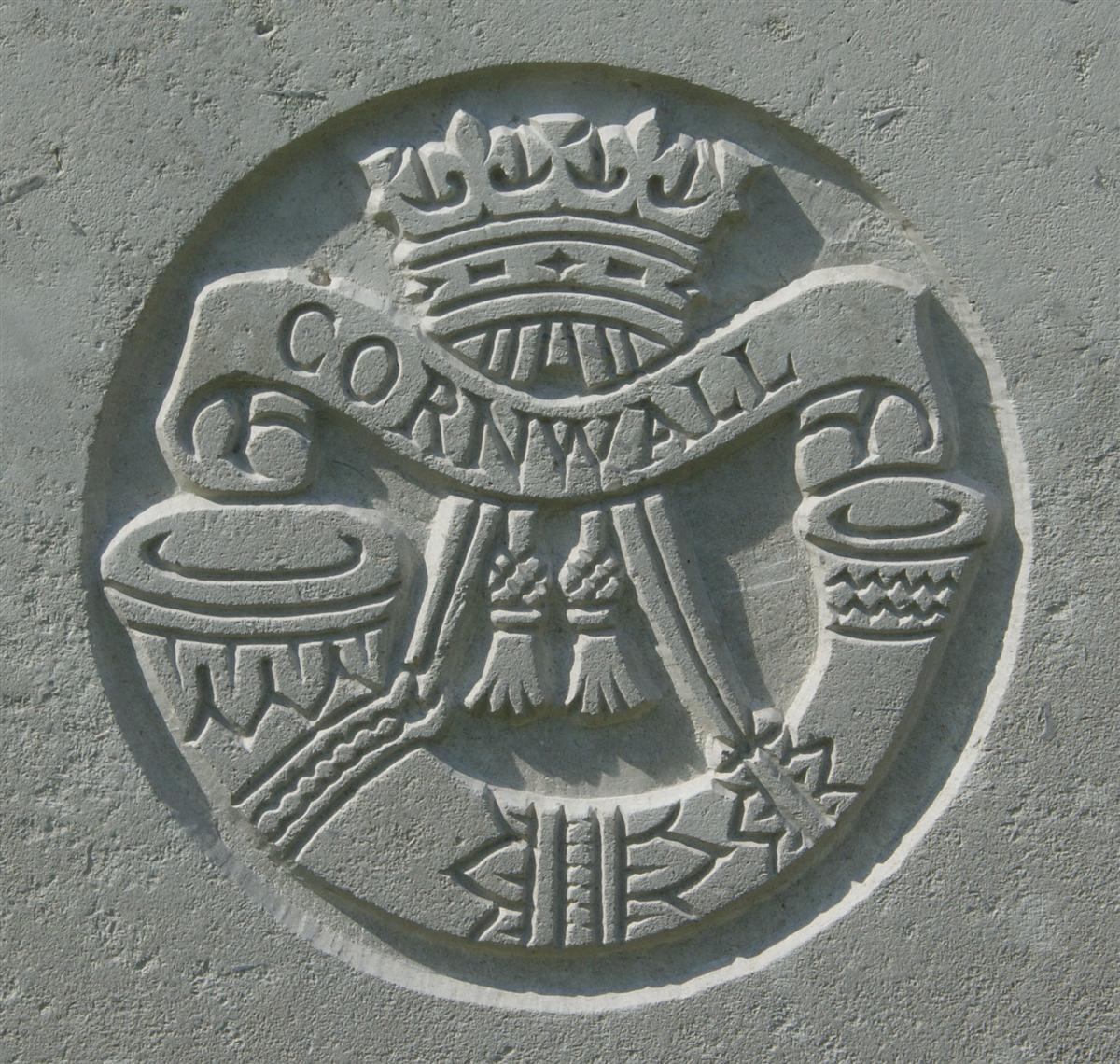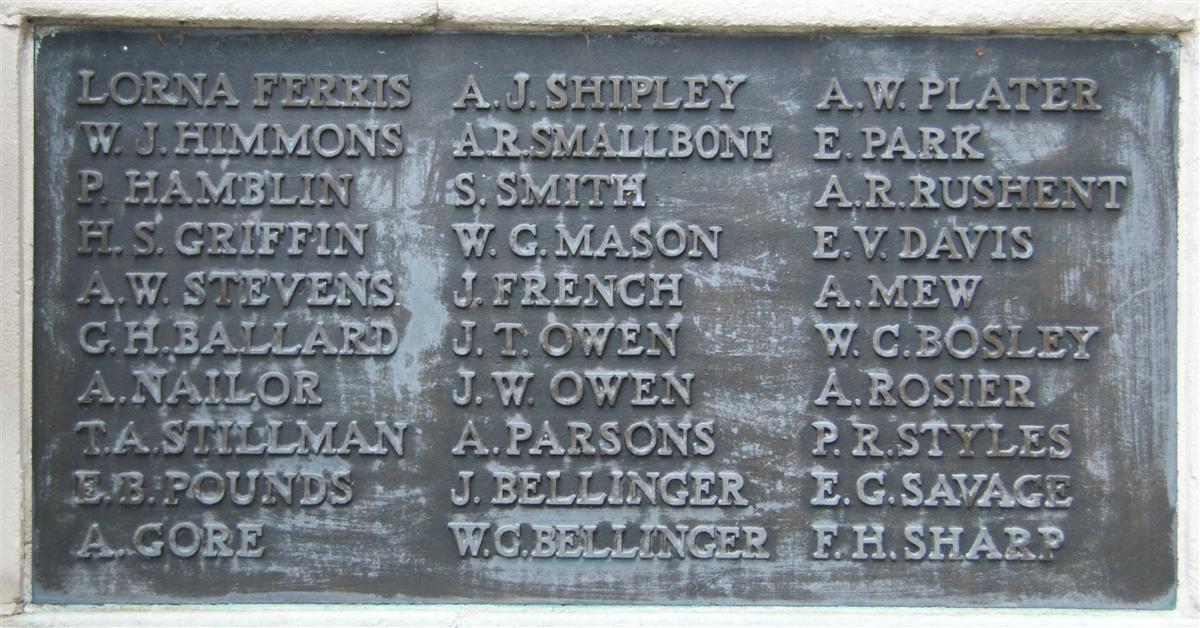William Charles Bosley
Private 37854 William Charles Bosley, 1st Battalion, Duke of Cornwalls Light Infantry
William was born in Thatcham in 1899, the youngest son of Charles Bosley and his wife Elizabeth (née Heath). His father was a tile maker, probably employed at the brick and tile works that gave the name to Kiln Road, then in Cold Ash but now part of Newbury. Elizabeth was Charles’ second wife his first wife, Catherine Soper, having died in 1889. He subsequently married Elizabeth on 30 August 1891 in Thatcham. Between them they had five children, four boys (George Daniel, Arthur John, Walter David and William Charles) and one girl (Evelyn May).
The family lived in Blanchard Cottage in Cold Ash before moving into Newbury, first to Shaw Crescent and then to Park Lane and finally to 23 King’s Road. After his schooling he may well have followed the example of his brothers Arthur and Walter, who both found work at the brickyard – no doubt helped to find work by their father.
When war was declared on 4 August 1914 William was too young to serve in the army; by the time he was old enough conscription had been introduced, so he would have received a notice to report for a medical very soon after his birthday in 1917. He was passed fit to serve in a combat battalion and sent for basic training with the Training Reserve (where his army number was 7/3133). In the spring of 1918 a massive German offensive shattered many of the British and Empire units in France; reinforcements were desperately needed. The War Office decided to lower the age limit on combat troops from 19 to 18½ in order to make available a large number of trained recruits in the UK – among whom was William.

The regimental badge of the Duke of Cornwall's Light Infantry, as used on CWGC headstones. |
So William found himself in France, serving with the 1st Battalion of the Duke of Cornwall’s Light Infantry (DCLI) in the 95th Brigade, 5th Division. This battalion had been recalled from the Italian Front in April 1918 to reinforce the front in France.
The Allies managed to stop the German advance by late April, thereafter the Alled war machine demonstrated how efficient it had become. Supplies poured into the forward areas, thousands of new troops with American accents were arriving. By the beginning of August the Allies were ready to go on the offensive and launched an attack on the area captured by the Germans in the spring, starting to the east of Amiens. The Germans had no answer for the superior resources and tactics of the Allies. Soon they were being pushed back towards the Hindenberg Line, the launch point of their Spring Offensive.
On 19 August William’s battalion had a rare treat – being allowed to sleep in until 10am. The following day they rested until the evening when they moved up to the front reaching their assemble position in Keane Trench at 2am. At 4.55am the attack began, led by the 1st Battalion, Devonshire Regiment and the 1st Battalion East Surrey Regiment with the 1st DCLI in support and the 12th Battalion Gloucestershire Regiment in reserve. The plan was for the 37th Division to capture positions designated the ‘blue line’ – literally a blue line on their maps – the 5th Division would then pass through the 37th to their own objectives.
War Diary, 1st Battalion Duke of Cornwall’s Light Infantry
21 August 1918 The Brigade was ordered to attack and capture the enemy’s positions on a line from G.31.d.7/5 to G24.b.8/6 [map references]. 1st Devons & 1st E Surreys in front line, 1st DCLI in Support and 12th Bn Gloucester Regiment in reserve. At 4.55am the attack commenced. There was no preliminary bombardment but the guns opened fire with a creeping barrage at ZERO. The 37th Division were to capture the Blue Line running from L.15.c through L.9.c and b – L.10.a to L.4.c and d and the 5th Division would then pass through. The mist was so thick that nothing could be seen after about 70 yards. Our Companies were due at the Blue Line at ZERO plus 110 and they moved off. D Coy on the right and C Coy on the left in front line with B Coy on the right and A Coy on the left in Support. Battalion Headquarters followed at about 6.15am.
The Blue Line was taken with very little resistance and Battalion Headquarters was established at L.8.b.9/2. Companies pushed on very well and many prisoners passed through our hands. Great difficulty was experiences in keeping direction owing to the mist but companies still pushed on and found themselves up with the front line.
Up to 9am no definite news came through but from information given by the wounded all was going well. The mist lifted about 8am, but almost immediately it came down thicker than ever.
At last messages came through. A message timed 8.40am from B Coy stated that with D Coy they were in the front line about L.16.c & that units of the 15th Bde were all mixed up with them. After re-organising they pushed on again and got to the line of the Brown Objective along the road in L.16.d.
Next came a message C Coy timed at 9.50am stating they had arrived at the Brown Objective about L.17.b.7/7 to the rear of the sunken road in L.17.c and that A were in the rear of them. All units commenced to re-organise in the Brown Objective and whilst doing so the mist suddenly lifted. Thes rather hindered operations so all units commence to dig in.
About 1.30pm the 12th Gloucesters came up in front of B and D Coys and the whole line moved forward again & reached roughly the line of the Red Objective from L.24.c running in a NW direction along the line of the railway. This line was also consolidated and Disposition of Brigade ran as follows:- 1st E Surreys on left and 12th Gloucesters on right in front line. Ist DCLI in Support with 1st Devons in reserve. Had the mist not lasted so long the final objectives would have undoubtedly been reached.
Casualties in our battalion were extremely light (2 Officers and 50 other ranks). 2/Lts R B Seaton & B D Johnstone were both wounded.
22 August 1918 Slight mist in the morning turning out into a fine hot day. There was a fairly heavy shelling of our position throughout the early morning and at about 4.30am the enemy opened a heavy barrage on our position. His infantry move forward to attack but were soon rounded up by the 12th Gloucesters and 250 prisoners were taken. The day passed fairly quietly except that the enemy shelled our position very heavily at intervals.
The story told by the war diary is typical for this phase of the war, constant British advances in the face of desperate defence by the demoralised Germans. However, casualties were still heavy – though 2 officers and 50 other ranks might seem ‘light’ to the diary writer, perhaps more accustomed to the casualty rates of the Somme, Paschendale or the Spring Offensive.
William is recorded as having been killed in action on 22 August 1918, probably a victim of the heavy shelling mentioned in the war diary. He was one of seven members of the battalion to die that day (one more died of wounds a few days later); a further 31 were wounded and two were recorded as missing - both of whom appear to have survived.

William's name on Newbury War Memorial (center right) |
His body was not recovered (further evidence in support of death by shellfire) so his name is remembered on panel 6 of the Vis-en-Artois Memorial to the Missing.
Locally he is remembered on the the town war memorial in Newbury (tablet 1).
He may also be the William Bosley on the memorial (now lost) to the pupils of Speenhamland School. However, this gives his regiment as the Royal Berkshire Regiment - suggesting it may be a different William Bosley (a W Bosley is also remembered on the Newbury memorial). However, it has been impossible to identify this second W Bosley, who could even be a second reference to William. As William lived in Shaw Road as a child, within the catchment area for Speenhamland School then, until an alternative and better explanation comes to light, it seems fair to assume that he was indeed named on their memorial, with an incorrect regimental affiliation.
His elder brothers were old enough to volunteer for service in the early months of the war:
Arthur enlisted in December 1914 or January 1915, joining the local infantry, the Royal Berkshire Regiment before being transferred to the Machine Gun Corps when it was formed in 1917. Wounded at the Somme he returned to the front and was wounded again at Passchendaele. On the second occasion his wounds were severe enough to warrant his discharge from the army on 18 April 1918. Fortunately they did not prevent him living a full life, he died in Newbury in 1975, aged 83.
Walter’s army service was not so impressive. He enlisted into the Royal Berkshire Regiment on 3 July 1915. It seems that he was not fit for combat duty so he was posted to a Pioneer battalion on 28 July. The day before this posting he was back in Newbury – at his wedding to Martha Jane Drewett. In August he was in the Alverstoke area where he broke into a shed and stole some overalls. Caught by the civilian police he was tried by the Gosport magistrates and sentenced to 2 months hard labour. This ended his military career – on 29 September 1915 he was ‘Discharged under para 392(x) Kings Regulations having been convicted by the Civil Powers of Felony. Authority 19/July/1903(D/AG|B) dated War Office 20.9.1915.’ Perhaps this lapse saved his life in the Great War but he still became a casualty of war, dying aged 47 when his home, 14 Appleby Terrace, Hull, was bombed on 8 May 1941.
Thanks to Karen Newbery for her help with research into this soldier.

